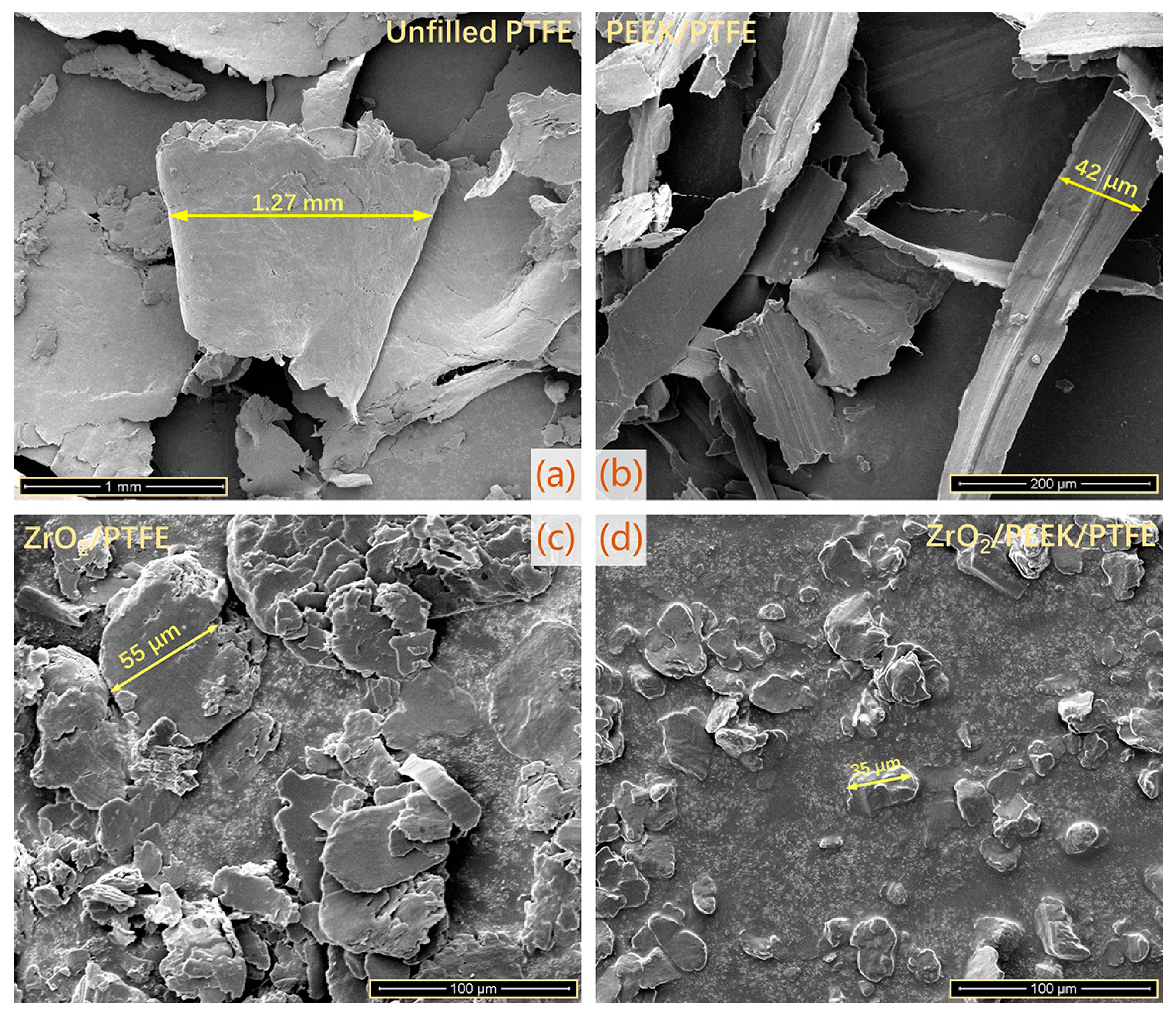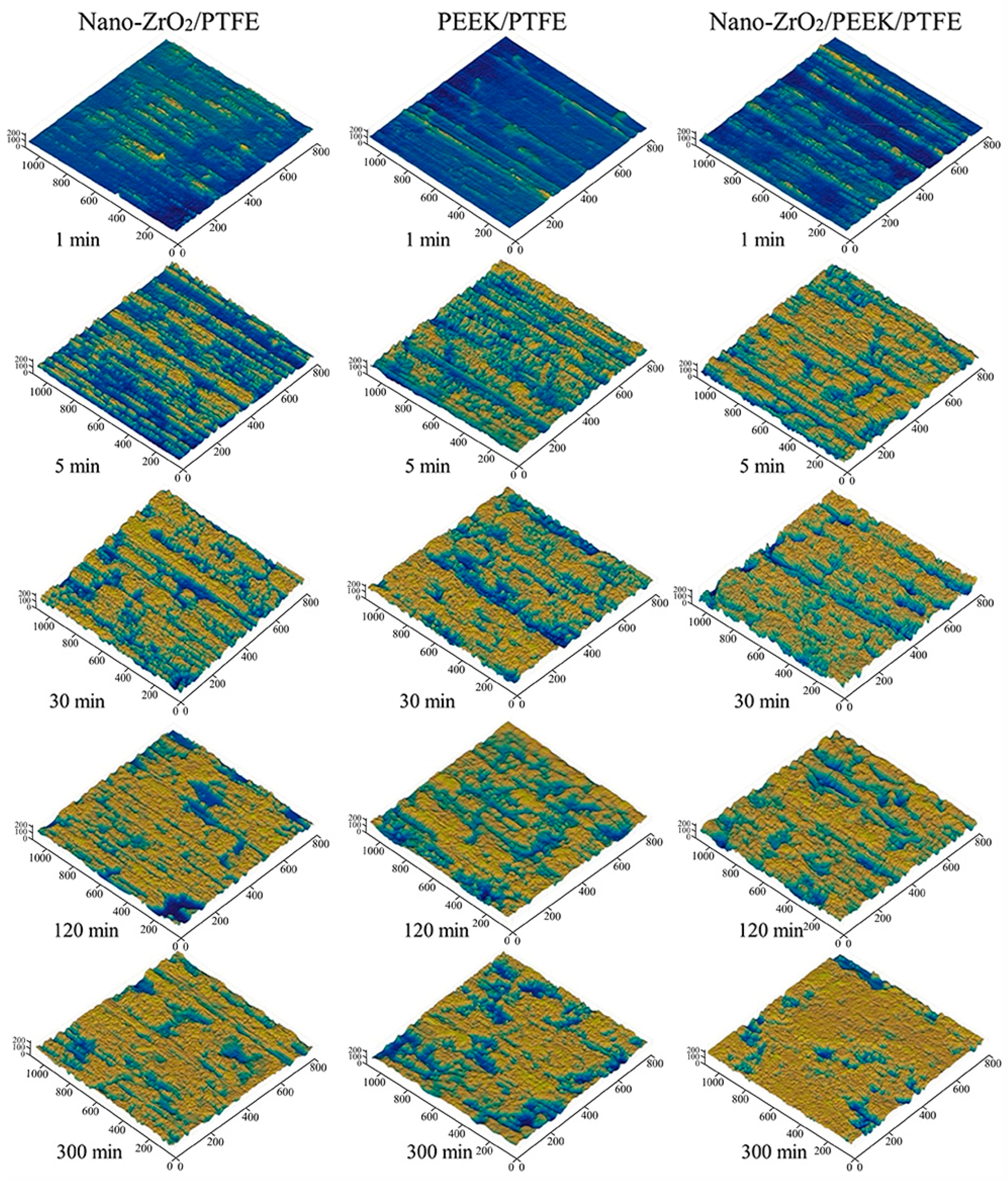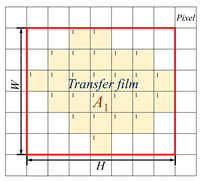Study of Tribological Properties and Evolution of Morphological Characteristics of Transfer Films in PTFE Composites Synergistically Reinforced with Nano-ZrO2 and PEEK Particles
Abstract
:1. Introduction
2. Materials and Methods
2.1. Specimen Preparation
2.2. Reciprocal Friction and Wear Test
2.3. Transfer Film Image Feature Recognition and Extraction Method
2.3.1. Preprocessing of Transfer Film Images
2.3.2. Transfer Film Image Segmentation and Edge Detection
2.3.3. Morphological Processing of Binary Images of Transfer Films
- (1)
- Expansion: A morphological operation that blends elements of the background area near the boundary of the target area into the target area.
- (2)
- Erosion: A morphological operation that removes the boundary points of the target area from the image.
- (3)
- Open operation: Erosion operation followed by expansion operation.
- (4)
- Closed operation: The expansion operation is performed first, then the erosion operation is performed.
2.3.4. Quantification of Image Features of Transfer Films
3. Results and Discussion
3.1. Synergistic Enhancement of Tribological Properties of PTFE Composites by Nano-ZrO2 and PEEK
3.2. The Morphological Evolution of the Transfer Film
3.3. Quantitative Analysis of the Evolution of the Morphological and Textural Characteristics of Transfer Films
4. Conclusions
- (1)
- Pure PTFE generated many flakes of considerable size (millimeter scale) during friction due to the slip motion between the carbon–carbon molecular chains, resulting in low wear resistance (3 × 10−4 mm3/Nm). Adding PEEK particles and ZrO2 nanoparticles to the PTFE matrix effectively suppressed interlayer slip and improved the shear deformation resistance of the matrix. The hard ZrO2 nanoparticles were highly efficient at cutting through debris detached from the matrix, resulting in a noticeable reduction in the size (micron scale) and the number of abrasive chips and, therefore, a significant improvement in the wear resistance of the PTFE composite (10−6 mm3/Nm). In particular, the volumetric wear rate of Nano-ZrO2/PEEK/PTFE was only 1.76 × 10−6 mm3/Nm at the late friction stage.
- (2)
- The PEEK and nanoparticles facilitated the formation of a firm and stable transfer film on the surface of the counterpart metal, and the nanoparticles, in particular, greatly increased the thickness of the transfer film during the stable friction phase, which also resulted in a higher coefficient of friction compared to pure PTFE. The soft PEEK particles dispersed in the matrix could effectively encapsulate the hard nanoparticles, which acted as a link between the PTFE matrix and the nanoparticles, so the increase in friction coefficient was not as large as that of Nano-ZrO2/PTFE.
- (3)
- The morphological characteristics of the transfer film evolved dynamically during the friction process, in which the transfer film’s coverage, roundness, third-order moment, and consistency showed an increasing trend. In contrast, the aspect ratio and texture entropy demonstrated a gradual decrease. The trend of these morphological characteristics indicated that the transfer film gradually fused during the friction process, and the haphazardness of the transfer film shape gradually decreased. The correlation analysis showed that the five morphological characteristics of transfer film coverage, area, mean value, third-order moment, and consistency exhibited a significant correlation with the volume wear rate of the PTFE composite.
Author Contributions
Funding
Institutional Review Board Statement
Informed Consent Statement
Data Availability Statement
Conflicts of Interest
References
- Speerschneider, C.J.; Li, C.H. Some observations on the structure of polytetrafluoroethylene. J. Appl. Phys. 1962, 33, 1871. [Google Scholar] [CrossRef]
- Bunn, C.W.; Cobbold, A.J.; Palmer, R.P. The fine structure of polytetrafluoroethylene. J. Polym. Sci. 1958, 28, 365–376. [Google Scholar] [CrossRef]
- Meng, Y.; Xu, J.; Jin, Z.; Prakash, B.; Hu, Y. A review of recent advances in tribology. Friction 2020, 8, 221–300. [Google Scholar] [CrossRef]
- Gweon, J.H.; Joo, B.S.; Jang, H. The effect of short glass fiber dispersion on the friction and vibration of brake friction materials. Wear 2016, 362, 61–67. [Google Scholar] [CrossRef]
- Huang, R.; Ma, S.; Zhang, M.; Yang, J.; Wang, D.; Zhang, L.; Xu, J. Wear evolution of the glass fiber-reinforced PTFE under dry sliding and elevated temperature. Materials 2019, 12, 1082. [Google Scholar] [CrossRef] [PubMed]
- Bandaru, A.K.; Kadiyala, A.K.; Weaver, P.M.; O’ Higgins, R.M. Mechanical and abrasive wear response of PTFE coated glass fabric composites. Wear 2020, 450–451, 203267. [Google Scholar] [CrossRef]
- Birleanu, C.; Marius, P.; Mircea, C.; Bere, P.; Glad, C.; Cristian, D.; Filip, D. Tribo-mechanical investigation of glass fiber reinforced polymer composites under dry conditions. Polymers 2023, 15, 2733. [Google Scholar] [CrossRef]
- Li, Y.; Chen, Y.; Guo, Y.; Bian, D.; Zhao, Y. Tribological behavior of PEEK/PTFE composites reinforced with carbon fibers and graphite. Materials 2022, 15, 7078. [Google Scholar] [CrossRef]
- Bhargava, S.; Makowiec, M.E.; Blanchet, T.A. Wear reduction mechanisms within highly wear-resistant graphene- and other carbon-filled PTFE nanocomposites. Wear 2020, 444–445, 203163. [Google Scholar] [CrossRef]
- Vasilev, A.; Nadezhda, L.; Struchkova, T.S.; Okhlopkova, A.A.; Danilova, S.N. Mechanical and tribological properties of polytetrafluoroethylene modified with combined fillers: Carbon fibers, zirconium dioxide, silicon dioxide and boron nitride. Polymers 2023, 15, 313. [Google Scholar] [CrossRef]
- Lei, F.; Hu, K.A.; Li, J.L.; Zhao, B.Y. The friction and wear characteristics of nanometer ZnO filled polytetrafluoroethylene. Wear 2001, 249, 877–882. [Google Scholar] [CrossRef]
- Yuan, Q.; Gong, J.; Cao, W.H.; Wang, H.G.; Ren, J.F.; Gao, G. Tribological behaviour of PTFE composites filled with PEEK and nano-Al2O3. Tribol. Trans. 2018, 61, 694–704. [Google Scholar] [CrossRef]
- Wang, Q.H.; Xue, Q.J.; Shen, W.C. The friction and wear properties of nanometre SiO2 filled polytetrafluoroethylene. Tribol. Int. 1997, 30, 193–197. [Google Scholar] [CrossRef]
- Alam, K.I.; Bragaw, P.; Burris, D.L. Isolating the tribochemical and mechanical effects of nanofillers on PTFE wear. Wear 2022, 494–495, 204256. [Google Scholar] [CrossRef]
- Song, F.; Wang, Q.; Wang, T. Effects of glass fiber and molybdenum disulfide on tribological behaviors and PV limit of chopped carbon fiber reinforced polytetrafluoroethylene composites. Tribol. Int. 2016, 132, 237–243. [Google Scholar] [CrossRef]
- Amenta, F.; Bolelli, G.; Pedrazzi, S.; Allesina, G.; Santeramo, F.; Bertarini, A.; Sassatelli, P.; Lusvarghi, L. Sliding wear behaviour of fibre-reinforced PTFE composites against coated and uncoated steel. Wear 2021, 486–487, 204097. [Google Scholar] [CrossRef]
- Kandanur, S.S.; Rafiee, M.A.; Yavari, F.; Schrameyer, M.; Yu, Z.-Z.; Blanchet, T.A.; Koratkar, N. Suppression of wear in graphene polymer composites. Carbon 2012, 50, 3178–3183. [Google Scholar] [CrossRef]
- Burris, D.L.; Sawyer, W.G. Improved wear resistance in alumina–PTFE nanocomposites with regular shaped nanoparticles. Wear 2006, 260, 915–918. [Google Scholar] [CrossRef]
- Sun, W.; Liu, X.; Liu, K.; Xu, J.; Lu, Y.; Liu, K. Mechanochemical functionality of graphene additives in ultralow wear polytetrafluoroethylene composites. Carbon 2021, 184, 312–321. [Google Scholar] [CrossRef]
- Xiao, W.; Ji, X. Effect of nano fillers on the properties of polytetrafluoroethylene composites: Experimental and theoretical simulations. J. Appl. Polym. Sci. 2021, 138, 51340. [Google Scholar] [CrossRef]
- Bahadur, S. The development of transfer layers and their role in polymer tribology. Wear 2000, 245, 92–99. [Google Scholar] [CrossRef]
- Harris, K.L.; Pitenis, A.A.; Sawyer, W.G.; Krick, B.A.; Blackman, G.S.; Kasprzak, D.J.; Junk, C.P. PTFE tribology and the role of mechanochemistry in the development of protective surface films. Macromolecules 2015, 48, 3739–3745. [Google Scholar] [CrossRef]
- Nunez, E.E.; Polycarpou, A.A. The effect of surface roughness on the transfer of polymer films under unlubricated testing conditions. Wear 2015, 326–327, 74–83. [Google Scholar] [CrossRef]
- Hu, L.; Zhong, W.; Dan, J.; Li, Y.; Yu, Q. A study of the tribological behavior of transfer films of PTFE composites formed under different loads, speeds and morphologies of the counterface. Wear 2015, 328, 17–27. [Google Scholar]
- Onodera, T.; Nunoshige, J.; Kawasaki, K.; Adachi, K.; Kurihara, K.; Kubo, M. Structure and function of transfer film formed from PTFE/PEEK polymer blend. J. Phys. Chem. C 2017, 121, 14589–14596. [Google Scholar] [CrossRef]
- Gosvami, N.N.; Bares, J.A.; Mangolini, F.; Konicek, A.R.; Yablon, D.G.; Carpick, R.W. Mechanisms of antiwear tribofilm growth revealed in situ by single-asperity sliding contacts. Science 2015, 348, 102–106. [Google Scholar] [CrossRef]
- Harris, K.L.; Curry, J.F.; Pitenis, A.A.; Rowe, K.G.; Sidebottom, M.A.; Sawyer, W.G.; Krick, B.A. Wear Debris Mobility, Aligned Surface Roughness, and the Low Wear Behavior of Filled Polytetrafluoroethylene. Tribol. Lett. 2015, 60, 2. [Google Scholar] [CrossRef]
- Ye, J.; Khare, H.; Burris, D.L. Quantitative characterization of solid lubricant transfer film quality. Wear 2014, 316, 133–143. [Google Scholar] [CrossRef]
- Ye, J.; Khare, H.; Burris, D.L. Transfer film evolution and its role in promoting ultra-low wear of a PTFE nanocomposite. Wear 2013, 297, 1095–1102. [Google Scholar] [CrossRef]
- Haidar, D.R.; Ye, J.; Moore, A.; Burris, D.L. Assessing quantitative metrics of transfer film quality as indicators of polymer wear performance. Wear 2017, 380–381, 78–85. [Google Scholar] [CrossRef]
- Lin, Z.; Zhang, K.; Ye, J.; Gao, B.; Tao, P.; Zhang, Z. Clarifying the importance of the running film to the ultra-low wear of the polymer composite by eliminating its individual effect. Tribol. Int. 2023, 180, 108201. [Google Scholar] [CrossRef]
- Urueña, J.M.; Pitenis, A.A.; Harris, K.L.; Sawyer, W.G. Evolution and wear of fluoropolymer transfer films. Tribol. Lett. 2015, 57, 9. [Google Scholar] [CrossRef]
- Alam, K.I.; Dorazio, A.; Burris, D.L. Polymers tribology exposed: Eliminating transfer film effects to clarify ultralow wear of PTFE. Tribol. Lett. 2020, 68, 67. [Google Scholar] [CrossRef]
- Sawyer, W.; Freudenberg, K.D.; Bhimaraj, P.; Schadler, L.S. A study on the friction and wear behavior of PTFE filled with alumina nanoparticles. Wear 2003, 254, 573–580. [Google Scholar] [CrossRef]
- Wang, Y.; Yan, F. Tribological properties of transfer films of PTFE-based composites. Wear 2006, 261, 1359–1366. [Google Scholar] [CrossRef]
- Zhang, L.; Xie, T.; Chen, K.; Li, W. Observation and analysis of the terrace-like structured transfer film of SiO2/PTFE composites. Tribol. Int. 2022, 170, 107526–107536. [Google Scholar] [CrossRef]
- Zhang, L.; Xie, T.; Chen, K.; Li, C.; Zhang, J. Quantitative characterization of the transfer film morphology of SiO2/PTFE composite. Wear 2021, 484–485, 204047. [Google Scholar] [CrossRef]
- Wahl, K.; Chromik, R.; Lee, G.Y. Quantitative in situ measurement of transfer film thickness by a Newton’s rings method. Wear 2008, 264, 731–736. [Google Scholar] [CrossRef]
- Gu, Y.; Wang, Z.; Peng, S.; Ma, T.; Luo, J. Quantitative measurement of transfer film thickness of PTFE based composites by infrared spectroscopy. Tribol. Int. 2021, 153, 106593. [Google Scholar] [CrossRef]
- Qi, Y.; Sun, B.G.; Wang, H.G.; Zhang, Y.; Gui, G.; Zhang, P.; Zheng, X.B. Quantitative measurement of morphological characteristics of PTFE composite transfer films based on computer graphics. Materials 2023, 16, 1688. [Google Scholar] [CrossRef]
- Otsu, N. A threshold selection method from gray-level histograms. IEEE Trans. Syst. Man Cybern. 1979, 9, 62–66. [Google Scholar] [CrossRef]
- Heath, M.; Sarkar, S.; Sanocki, T.; Bowyer, K. Comparison of edge detectors: A methodology and initial study. Comput. Vis. Image Underst. 1998, 69, 38–54. [Google Scholar] [CrossRef]











| Material | PTFE (Vol.%) | PEEK (Vol.%) | Nano-ZrO2 (Vol.%) |
|---|---|---|---|
| Pure PTFE | 100 | 0 | 0 |
| PEEK/PTFE | 90 | 10 | 0 |
| Nano-ZrO2/PTFE | 92 | 0 | 8 |
| Nano-ZrO2/PEEK/PTFE | 82 | 10 | 8 |
| Shape Feature | Definition | Calculation Formula |
|---|---|---|
Perimeter of the transfer film (L) | The transfer film boundary’s pixel points are arranged to form a closed boundary. The Euclidean distance d between two adjacent pixel points on the boundary is calculated in turn using the 8-chain code method, and the sum of the distances d is the perimeter of the transfer film boundary L. | |
Area covered by transfer film (A1) | The target area is displayed in white with a pixel value of 1. The background area is black with a pixel value of 0. The sum of the number of pixels in the image with a pixel value of 1 is calculated as the area covered by the transfer film. | |
| Coverage ratio of transfer film (r) | The ratio of the area covered by the transfer film to the area not covered by the transfer film. | |
| Roundness of transfer film (C) | C reflects the degree to which the target area is close to a circle. A higher value of roundness indicates that the shape of the transfer film area is closer to a circle. | |
Rectangularity of transfer film (R) | The ratio between the area of the target region and the area of its smallest external rectangle. R reflects how close the shape of the transfer film is to a rectangle. | |
| Remarks | x and y are the values of the horizontal and vertical coordinates of the pixel points respectively. I is the pixel value A is the total number of pixel points in the image. W and H represent the width and height of the transfer film area respectively. | |
| Textural Feature | Definition | Calculation Formula |
|---|---|---|
| Mean value of transfer film (M) | M is the average luminance value of all pixels in the area of the transfer film, which reflects the overall brightness of the transfer film. | |
| The third-order moment of transfer film (μ3) | μ3 measures the skewness of the grey-scale histogram of the transfer film image and thus determines the symmetry of the histogram. | |
| Uniformity of transfer film (U) | U reflects the smoothness of the texture in the transfer film image. A higher value of uniformity indicates a smoother texture in the image; conversely, a lower uniformity indicates a rougher image. | |
| Texture entropy of transfer film (E) | E reflects the variability and complexity of the texture in a transfer film image. A higher entropy value indicates a more complex transfer film image; conversely, a lower entropy value indicates a less complex image. | |
| Remarks | zi is a random variable in the grey level of the image. G is the grey level of the image. P(zi) is the corresponding grey histogram of the image (i = 0, 1, …, G − 1). μ2 is the second-order moment of the mean value M. | |
| Morphological Characteristics of the Transfer Film | Nano-ZrO2 PTFE | PEEK PTFE | Nano-ZrO2 PEEK PTFE | |
|---|---|---|---|---|
| Geometrical characteristics | Overall coverage ratio | 0.991742451 | 0.995184464 | 0.970536919 |
| Area of the individual transfer film | 0.903301132 | 0.931414003 | 0.932489267 | |
| Aspect ratio | 0.7468347327 | 0.8370890552 | 0.788524198 | |
| Roundness | 0.529314952 | 0.682693702 | 0.755553724 | |
| Rectangularity | 0.235274832 | 0.713107776 | 0.113152496 | |
| Textural features | Mean value | 0.901197369 | 0.933141344 | 0.969658099 |
| Third−order moments | 0.976515695 | 0.945376412 | 0.998476153 | |
| Consistency | 0.912254056 | 0.921862415 | 0.952934061 | |
| Texture entropy | 0.792752312 | 0.642134468 | 0.932279773 | |
Disclaimer/Publisher’s Note: The statements, opinions and data contained in all publications are solely those of the individual author(s) and contributor(s) and not of MDPI and/or the editor(s). MDPI and/or the editor(s) disclaim responsibility for any injury to people or property resulting from any ideas, methods, instructions or products referred to in the content. |
© 2023 by the authors. Licensee MDPI, Basel, Switzerland. This article is an open access article distributed under the terms and conditions of the Creative Commons Attribution (CC BY) license (https://creativecommons.org/licenses/by/4.0/).
Share and Cite
Qi, Y.; Sun, B.; Zhang, Y.; Gao, G.; Zhang, P.; Zheng, X. Study of Tribological Properties and Evolution of Morphological Characteristics of Transfer Films in PTFE Composites Synergistically Reinforced with Nano-ZrO2 and PEEK Particles. Polymers 2023, 15, 3626. https://doi.org/10.3390/polym15173626
Qi Y, Sun B, Zhang Y, Gao G, Zhang P, Zheng X. Study of Tribological Properties and Evolution of Morphological Characteristics of Transfer Films in PTFE Composites Synergistically Reinforced with Nano-ZrO2 and PEEK Particles. Polymers. 2023; 15(17):3626. https://doi.org/10.3390/polym15173626
Chicago/Turabian StyleQi, Yuan, Bugong Sun, Yang Zhang, Gui Gao, Peng Zhang, and Xiaobao Zheng. 2023. "Study of Tribological Properties and Evolution of Morphological Characteristics of Transfer Films in PTFE Composites Synergistically Reinforced with Nano-ZrO2 and PEEK Particles" Polymers 15, no. 17: 3626. https://doi.org/10.3390/polym15173626
APA StyleQi, Y., Sun, B., Zhang, Y., Gao, G., Zhang, P., & Zheng, X. (2023). Study of Tribological Properties and Evolution of Morphological Characteristics of Transfer Films in PTFE Composites Synergistically Reinforced with Nano-ZrO2 and PEEK Particles. Polymers, 15(17), 3626. https://doi.org/10.3390/polym15173626






